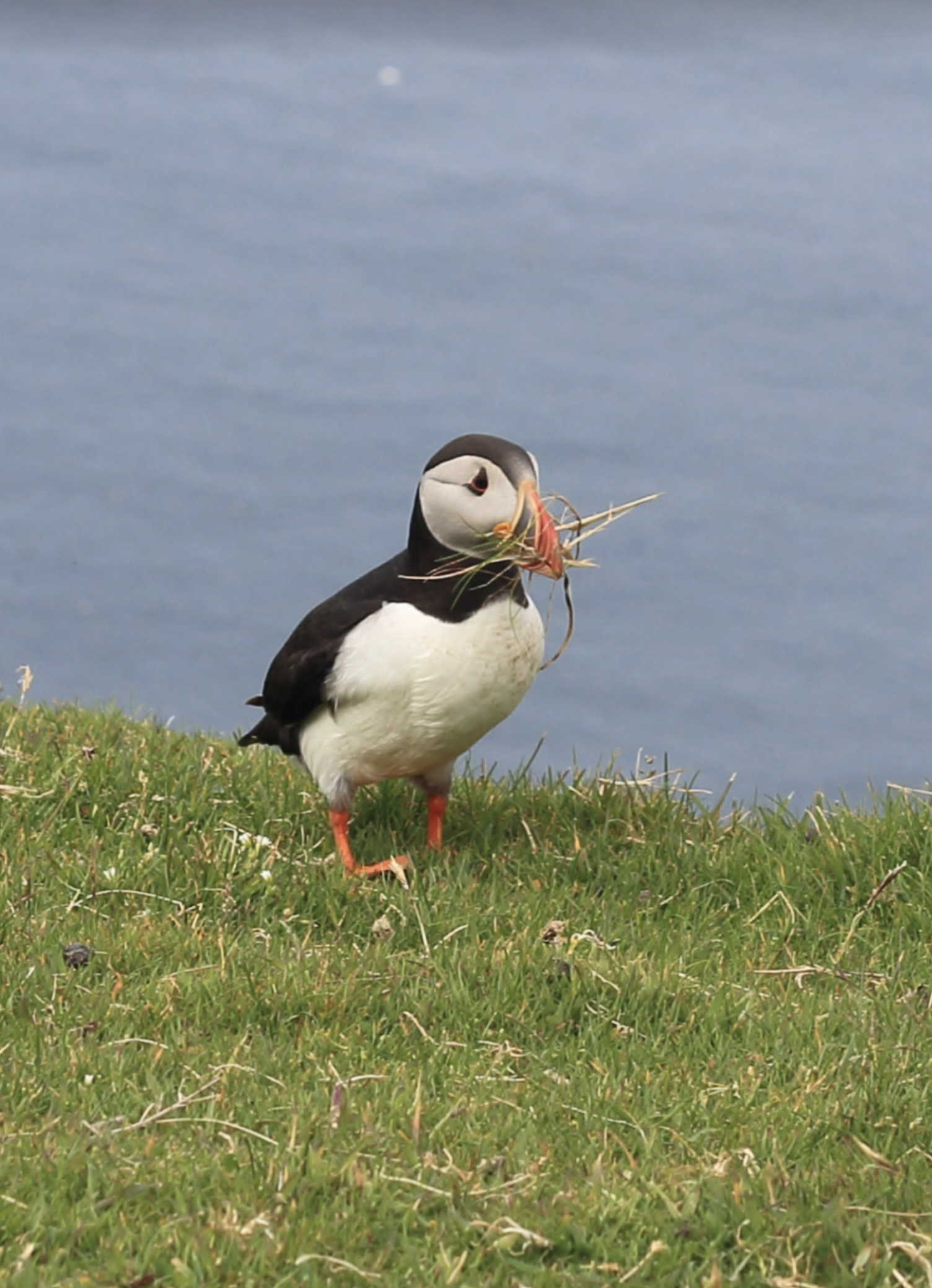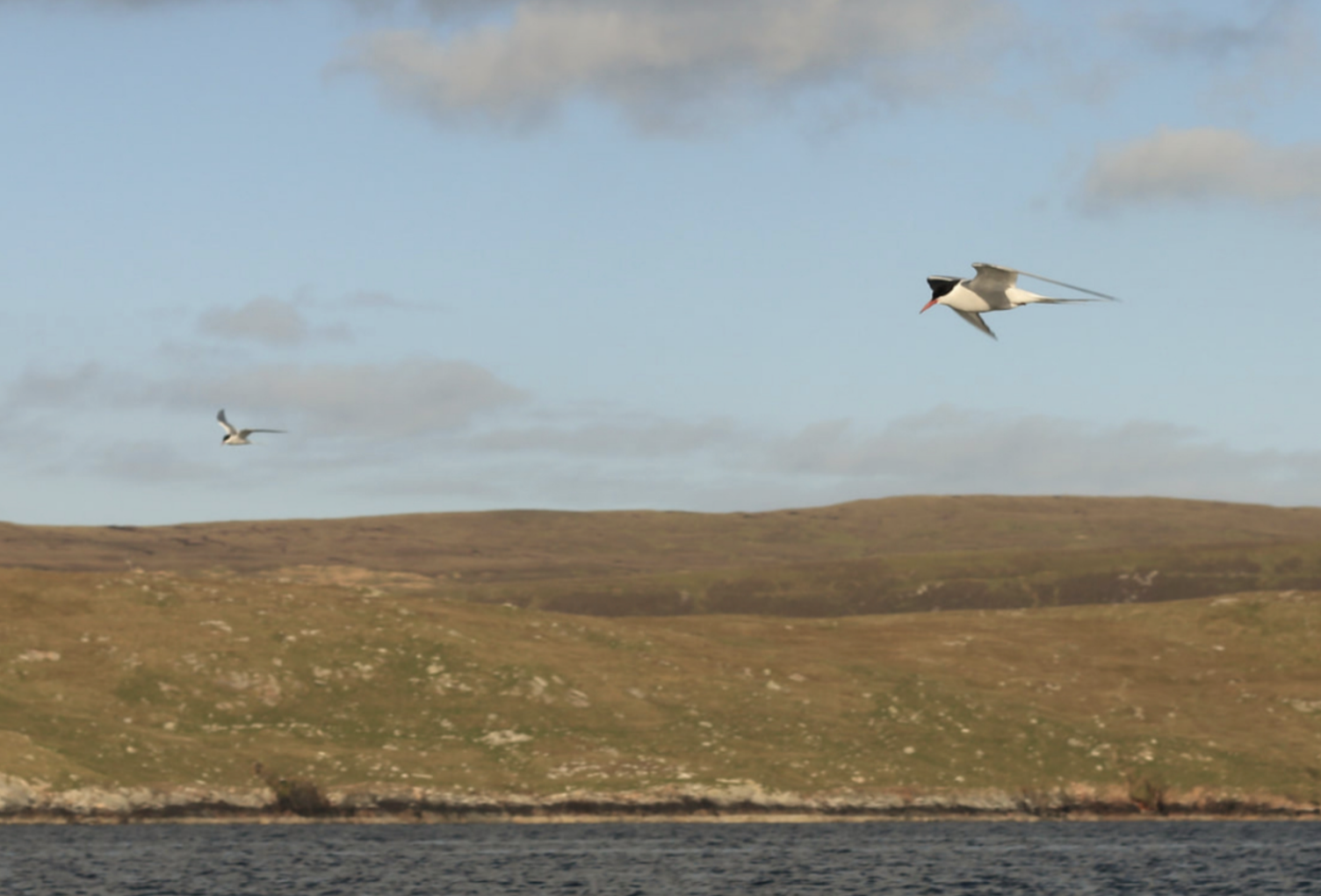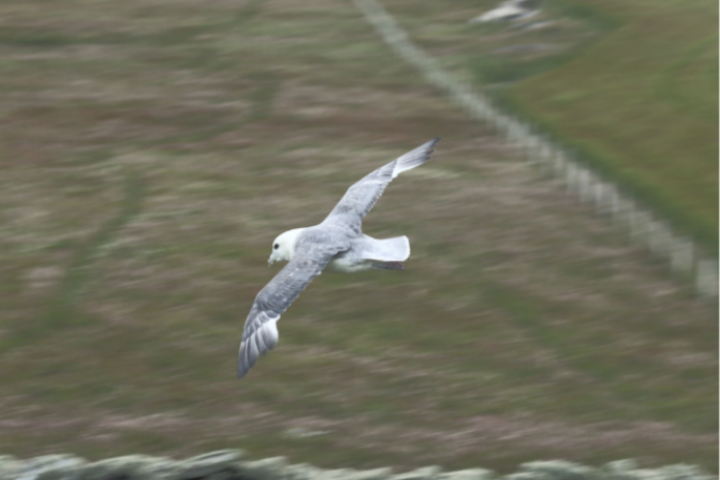Shetland's summer seabirds
An Arctic Tern at midsummer with Foula in the background
The return of the seabirds is one of my favourite times of the year. It’s filled with hope and the reassurance that, despite everything, the cyclical processes that guide the natural world continue regardless of the latest news story that’s making the headlines and keeping us awake at night.
Shetland is a birders paradise, with over one million nesting seabirds returning to their noisy colonies every summer, breeding on cliffs, moors, beaches and, even within the walls of a 2,000-year-old broch, their return is a welcome sight after a long winter.
People often ask why the seabirds only return to land in the summer, and the answer is simple. Seabirds can’t lay an egg at sea, so they have to come ashore to breed. Once breeding is complete and the chick/s has fledged, they return to the sea – sometimes thousands of miles from the breeding grounds.
A puffin gathering nesting material at Hermaness
Puffins (Tammie Nories)
These are always the most popular among guests to Shetland, and they belong to the auk family. Their comical behaviour and distinctive, colourful bills make them quite the cliff-side showstopper. Puffins, or Tammie Nories as they are known locally, occupy the penthouse apartment on the cliffs. Puffins need to live at the cliffs' top because they nest in burrows, so they need soil to burrow. Some of these are 6ft deep! In here, puffins will rear one chick, known as a puffling. Puffins are incredibly graceless fliers; their flight is fast and involves – what would appear to be – a disproportionate amount of wing-flapping. Outside the short breeding season (April-August), the puffins return to the sea, spending the winter in the North Atlantic and the Arctic Ocean. Puffins, like most seabirds, are monogamous and return to the same partner each year and can expect to live to be about 20 years old.
The best place to see puffins is at Sumburgh Head or Hermaness.
Arctic terns fishing at sea
Arctic terns (tirricks)
Arctic tern preparing to dive for fish
This is my favourite of the seabirds, and their shrill call is, to me, the sound of a Shetland summer. These remarkable little birds, often called sea swallows, travel further than any other seabird on their annual migration (up to 50,000 miles) and see more daylight than any other species. It’s said that an Arctic Tern will fly the equivalent distance to the moon and back in their lifetime. Be aware if you are in the vicinity of an Arctic Tern colony, these birds are extremely aggressive when defending their young.
Arctic tern preparing to dive for fish
Nesting on beaches, Terns will dive-bomb anyone who comes too close to the nesting area.
Common Terns also breed in Shetland. These are less abundant than Arctic Terns, and they are difficult to differentiate between.
Arctic terns can be seen nesting at Mousa and Grutness – you can also see them in Lerwick Harbour throughout the summer.
Shags, with wings outstretched, on rocks off Shetland's west coast
Cormorants & shags (skarfs)
These resident birds are very similar and difficult to tell apart, and we have both here in Shetland, although shags are more common. The cormorant is larger and has a thicker neck than the shag, and only nests on Shetland’sShetland’s west side. Someone once told me that they call shags Dracula birds as they are often seen standing on the rocks with their wings outstretched, like Dracula. This is a method of drying their wings, and it’s common to see a row of birds lined up with their wings out. Shags build scruffy nests in the cliffs, and, very often, unusual shiny things will turn up in them – a nest in Fair Isle was once found to have a screwdriver in it!
Shags and cormorants are resident birds and can be seen all around the coast of Shetland all year round.
A fulmar resting on the water
Fulmars are relatively new to Shetland and didn’t arrive here until the late 19th century when they followed returning fishing boats from Faroe. Today, they are our most abundant seabird, with over 250,000 breeding pairs. They look like gulls but are, in fact, a relation of the albatross.
These birds remain all year round and occupy cliff faces across Shetland. Beware not to get too close as they protect their nests by spitting out foul-smelling stomach acid.
Fulmars are found nesting on all cliffs around Shetland. In Lerwick, you’ll find them at the Knab and Sumburgh Head is always a good place to see them.
Gannets flying at the back of Noss
Gannets (solans)
These are the largest seabirds that are found in Shetland and, with their black eyeliner and graceful flights, are elegant and majestic. They are impressive to watch as they fish, tucking in their wings and darting into the water like a torpedo. Under the water, they are able to use their wings to move around and swim. Gannets nest in dense colonies on cliffs and stacks and are extremely successful in Shetland.
The best place to see Gannets is at Hermaness and Noss.
A dense guillemot colony at Sumburgh Head
Guillemots
Guillemots are small black and white seabirds and are part of the auk family. They look a little like miniature penguins, and they nest in dense colonies, often at the foot of cliffs. They have a ‘safety in numbers’ approach and, when a predator is near, the colony will all stand with bills pointed into the air to deter them. Guillemots don’t build nests; instead, they lay patterned eggs with pointed ends. It’s said that the pointy eggs prevent them from rolling off the ledges. However, a more recent study has suggested that the egg shape means less surface area is on the rocks, therefore less chance of bacteria entering the porous egg. As soon as a guillemot chick can, the male encourages the chick to leap into the water. Once in the water, the male guillemot will lead the chick out to sea, away from the risk of predators looking for a quick meal in the breeding colonies.
Sumburgh Head is an excellent place to see guillemots in their noisy colonies. The warden there once told me that she calls them “gigglymots” because of the noise they make. It stuck, and for me, they will always be gigglymots.
Kittiwake in flight
Kittiwakes
These are wonderful birds and not commonly seen. They are a small gull and often mistaken as a common gull. They are easily distinguishable by their black legs and wingtips that look like they’ve been dipped in ink. A kittiwake’s name is onomatopoeic, and in Shetland, their numbers have been in steep decline in recent years. Like puffins, kittiwakes depend on sand eels, and any changes to the patterns of fish can be the difference between a successful breeding season and a failed season. Changes in sea temperature can result in fish shoals moving offshore, leading to a poor or ultimately unsuccessful breeding season for some seabirds.
Kittiwakes can be seen at Sumburgh Head and Noss.
Razorbill
Razorbills
Razorbills are quite elusive birds, real introverts at heart, who tend to nest alone in crevices and crags on the cliffs rather than in noisy, social colonies. Like puffins and guillemots, Razorbills are also part of the auk family and are migratory summer visitors who return here for the breeding season. The bill of a razorbill makes them easy to spot. They are similar to that of a puffin but in monochrome colours, striped black and white and lacking the vivid colouration that puffins have. Although monogamous, razorbill males will often be seen to sneak off and visit the nest of other females!
Razorbills can be seen at Sumburgh Head.
Great skua in flight, Noss
Great Skua (bonxie)
These large brown birds are incredibly intimidating and can be immensely aggressive if you venture into their breeding grounds during the breeding season. Great skuas, known locally as bonxies, nest on open moorland areas in clusters and will dive-bomb anything that may be a threat to their chicks. Great skuas are in decline worldwide, and Shetland is said to have 40 per cent of the world’s breeding population of these aggressive birds. Although endangered worldwide due to their predatory habits, great skuas are not a favoured bird within the isles.
Bonxies can be seen nesting at Hermaness and Noss.
If you come to Shetland, I would recommend buying a copy of Shetland Summer Birds, a handy little pocket guide to the birds you can expect to see.
You can buy this online from the Shetland Times Bookshop.
Happy birding!















